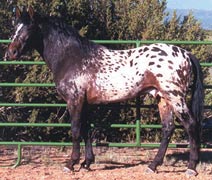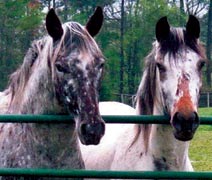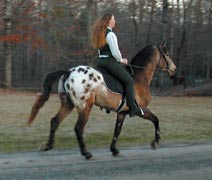
|
Return to Breed Profiles Main Page The Tiger Horse
Coat and Gait LEOPARD COMPLEX COAT patterns are caused by a single dominant gene Lp Lp (Sponenberg) which is influenced by a modifier to create a myriad of patterns, including mottled, frost, snowflake, varnish, roan, speckled, blanket, leopard and few-spot leopard, referred to as "Ghost Horses". They can occur alone or in combinations and may change over the course of the horse's life. Other classic "Appaloosa" characteristics also include mottled skin of the mouth, around eyes and genitalia, white sclera and striped hooves. Be aware these things can occur in non-leopard complex horses, and they do not all always occur in leopard complex horses. The Tigre registry narrows their color recognition down to Ghost, Leopard and roan. Both registries accept any four-beat saddle gait, with even-timed gaits (running walk, rack) being preferred. Though many Appy-patterned horses gait naturally, out-crossing non-gaited patterned horses with non-patterned gaited horses was necessary to build a genetic base for the breed. This opens the door for a range of gaits and the body types. Pointing to early Spanish influence, many breeders strive for "Spanish conformation". Comments TIGRE's Victoria Varley, "rat tails are acceptable and sometimes present in the Tiger Horse but not common. Our horses tend to be Spanish in type so full flashy manes and tails are more the norm in our breed." Then and Now
Horses have sported spots since antiquity, including the Altai of Siberia, and individuals of the ambling, Ferghana "Heavenly Horses". Historians document that leopard complex horses were a fad in Spain, Holland, Germany, Denmark, France and Austria during the mid-1700's, only to fall out of fashion by the end of the century. Boat loads were shipped off to Mexico and California and "the colonies". Historical accounts describe some of these cast-offs as almost identical to spotted Indian ponies later found in the Pacific Northwest. Lewis and Clark documented Appy-patterned horses in the Palouse region of the Columbia Basin (Idaho, Washington) in 1805. Whether, as lore holds, the native residents bred the horses, or traded or stole them is a matter for historical debate. And feelings among the Appaloosa and American Indian communities as to whether the original horses were gaited are mixed. The Appaloosa Horse News addressed the Indian Shuffle gait in an article in 1978: "Rough country cowmen... are quick to point out that his natural traveling gait, the Indian shuffle, a seemingly tireless running walk, is a characteristic of this cleanlegged horse..." "When the (Appaloosa) breed registry was formed ..., many of the foundation horses came by this gait naturally, as their ancestors had before them. It has been said that Gene Autry used to show off the gait of his Appaloosa EL MORROCO F?18 by... placing a glass of water on the horn and riding off at full speed without spilling a drop." But gaited Appaloosas were not always sought after. "In the show ring the shuffle is not an asset. A horse that deviates from the walk, trot and canter is disqualified. ...Breeders with their eyes on the "blues" would not keep a shuffler for long." Thankfully, wiser heads prevailed and the comeback of gaited, Appaloosa-patterned horses is well on its way. Projections for the future vary between the two registries, as do their philosophy and objectives. But both seek to preserve and protect the Tiger Horse. Associations
TIGRE states, "We are involved in the creation ... of a new horse as one can never bring back a horse from extinction. (We) are creating an American version using improved, larger stock. Being scientifically informed keeps us on the right track to our stated goals ... to create a magnificent, exotic breed of horse with the strongest possible middle gait, averaging 15 Hands high and of impeccable, people loving disposition and straight profile. Already a very specific type is emerging from these experiments." The Tiger Horse Association comments, "The Tiger Horse Association is the original registering body to use the name "Tiger" for horses of Colonial Spanish/American type, loud leopard (appaloosa) coloration, and easy to ride four-beat gait. The T.H.A. ... exists to find whatever individual horses there are of the Tiger type. The goal of the T.H.A. is to register, preserve, promote and provide exhibition venues for these horses." For more information contact: TIGRE, The Tiger Horse Registry, Phone: (505) 438-2827 The Tiger Horse Association, Inc., Phone: (540) 297-2276 or (540) 890-6832 |

 WITH A CONTROVERSIAL HISTORY, Tiger Horses are best first described in terms of today's horse. The breed is characterized by "Appaloosa" spotted coats and easy gaits. Though countless breeds the world over have carried the leopard complex of coat patterns, Americans are most familiar with the Appaloosa breed, to the point of referring to their coat patterns as "Appaloosa". Tiger Horses may perform any of the easy gaits, including the "Indian shuffle", a catchall term for a four-beat saddle gait with minimal lift.
WITH A CONTROVERSIAL HISTORY, Tiger Horses are best first described in terms of today's horse. The breed is characterized by "Appaloosa" spotted coats and easy gaits. Though countless breeds the world over have carried the leopard complex of coat patterns, Americans are most familiar with the Appaloosa breed, to the point of referring to their coat patterns as "Appaloosa". Tiger Horses may perform any of the easy gaits, including the "Indian shuffle", a catchall term for a four-beat saddle gait with minimal lift. THE TIGER HORSE is named for the French and Spanish, "Tigre", meaning big cats with patterned coats, which includes those with spots.
THE TIGER HORSE is named for the French and Spanish, "Tigre", meaning big cats with patterned coats, which includes those with spots. The two associations are very different in their approach.
The two associations are very different in their approach.